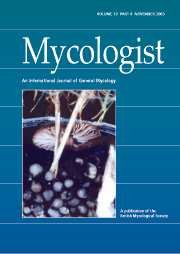Article contents
Krieglsteinera lasiosphaeriae: a mycoparasite on Lasiosphaeria ovina – new to Britain (NBR 224), Norway, Russia and the USA
Published online by Cambridge University Press: 03 December 2003
Abstract
The mycoparasite Krieglsteinera lasiosphaeriae Pouzar was first invalidly and illegitimately published by Arnaud (1951) as Jacobia conspicua from a collection near Paris. Although he thought that the sporophores resembled basidia, he described it as a hyphomycete (characterized by the large clamp-connexions) on the basis of the successive spore production. Pouzar (1987) later collected this fungus from Czechoslovakia and Poland and determined that the sporogenous branches described by Arnau were actually basidia. He appropriately redescribed it as a heterobasidiomycete renaming it Krieglsteinera lasiosphaeriae Pouz. after the German mycologist, J. Krieglsteiner. At the same time it was placed in its own family, Krieglsteineraceae, which is now considered a synonym of Platygloeaceae in the Urediniomycetes (Kirk et al., 2001). Pouzar believed that K. lasiosphaeriae was endangered and should be included in the red data book of Central European mycota owing to the rapid decrease of its host caused by air pollution. However, since then it has been found in Denmark (Læssoe & Lange, 1998) and is now reported here for the first time from England, Norway, Russia and the United States. Krieglsteinera lasiosphaeriae is probably much more abundant than previously thought, but is infrequently observed due to its cryptic nature.
- Type
- Original Article
- Information
- Copyright
- © 2003 Cambridge University Press
- 1
- Cited by




